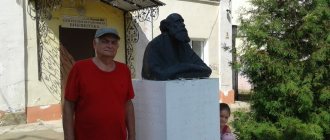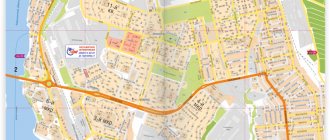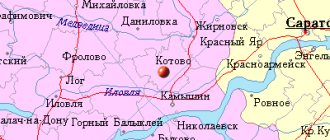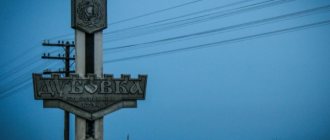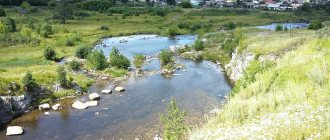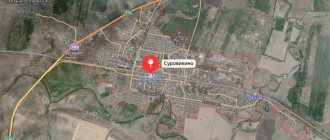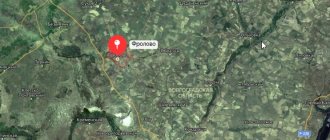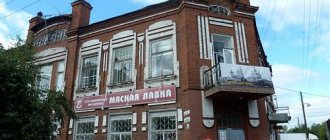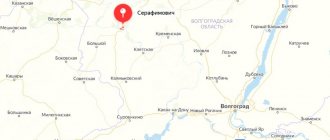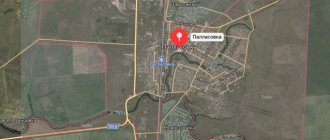| City of Tara, 2004 |
Tara
, a city in Russia, the administrative center of the Tara district of the Omsk region, the cathedral city of the Tara and Tyukalin diocese. Located on the left bank of the river. Irtysh, 285 km from the railway. Lyubinskaya station, 302 km north of Omsk. Road junction. Population - 27.6 thousand people (2012).
- On the map: Yandex.Map, Google map
The sixth city founded in Siberia.
The first Russian settlement on the territory of modern Omsk region. Founded in 1594 by governor Prince Andrei Vasilyevich Eletsky to protect the Upper Irtysh volosts from attacks by Khan Kuchum and the non-peaceful Tatars. The royal order to Prince Yeletsky said: “Go to the city and put it up the Irtysh on the Tara River, where it would be more profitable for the sovereign in the future, in order to establish arable land and exhaust the Tsar’s Kuchum and bring in salt...”
.
Having examined the mouth of the Tara River (hydronym Tara - from the Turkic tar
- “narrow”), Prince Yeletsky decided that the low, swampy lands on the river were not suitable for establishing arable land and were not convenient for building a city. The location was chosen on the high left bank of the Irtysh near the Arkarka River. It was the most elevated territory, surrounded on the west by swampy, difficult-to-pass lowlands, on the south and north sides by ravines, and on the east by the floodplain of the Irtysh and Arkarka rivers.
However, there is a version according to which the city was originally built at the mouth of the Tara River (where Ust-Tara is now). Then, in 1669, after a fire or great flood, it was moved to its present location [1].
The city burned down almost completely at least five times (including in 1629 and 1658 and 1669 (?)) [2].
| Watercolor drawing of the city of Tara in 1734 (from the LORAN archives), from the site taragorod.ru |
During almost the entire 17th century, Tara was considered a border town with Dzungaria and the Kyrgyz nomads and was of great importance as a strategic point from which the Russians launched their expeditions to the foothills of the Altai and Central Asia.
At this time, a lively barter trade began in the city with Dzungaria, Bukhara and Tashkent. In 1697, the city was included in the department of the Tobolsk category, in 1708 it was assigned to the Siberian province, and from 1719 - to the Tobolsk province.
With the construction of the Omsk fortress in the 18th century, when the Siberian Highway passed south of Tara, the city lost its strategic and commercial importance.
Since 1782 - a district city of the Tobolsk region of the Tobolsk governorship (since 1796 - Tobolsk province).
The military stage road from Tobolsk to Tomsk passed through Tara.
In the early 1880s, in the district city of Tara, Tobolsk province, there were 6 Orthodox churches, a mosque, 952 houses, a district and parish school, a girls’ school, a postal station, and a prison castle. There were 2 lard factories, 1 soap factory, 6 candle factories, 5 tanneries, 1 distillery, 3 brick factories, 18 forges, and a steam flour mill.
| Tara. View from the bell tower of the Spasskaya Church, 1916. Photos from the personal archives of A.A. Zhirov, from the site taragorod.ru |
Trade fairs – Annunciation (from March 20 to May 20) and Ekaterininskaya (from November 24 to December 20) – gathered a lot of people.
They traded clothes, shoes, leather, fish, livestock and harness, furs (squirrel, fox, beaver, ermine). Among the crafts, silversmithing, blacksmithing and painting were developed. At this time, the city belonged “according to the satisfaction of its residents, to the best cities of the Tobolsk province” [3]. According to information from 1900, the city had a printing house, 2 photographs, a city pawnshop, a city public library, a telegraph, charitable institutions: a charity home for the poor (opened in 1882), a syrup feeding house of commerce for Councilor Ya.A. Nemchinov, a shelter for exiles (opened in 1890).
At the beginning of the century, in comparison with the cities located on the railway line, the importance of Tara fell.
From June 1918 to November 1919, troops of A.V. were stationed in Tara. Kolchak.
Modern Tara is the second largest regional center of the Omsk region. Here are a branch of the Omsk Television Plant; meat, butter, cheese and mill plants; fisheries, breweries, brick factories; shoe and clothing factories.
Statistics
- 1869 - 7091 people
- 1897 - 7220 people
- 1906 - 7.6 thousand people (of which 2.3 thousand were exiles)
- 1913 - 11.2 thousand people
- 1926 - 10.3 thousand people
- 1939 - 15.4 thousand people
- 1959 - 22.6 thousand people
- 1992 - 26 thousand people
- 2005 - 26.9 thousand people
Religion
Since 1620 - within the Siberian and Tobolsk diocese. In the early 1620s, Archbishop Cyprian established the Spassky Monastery and Pyatnitsky Convent in the city.
At the beginning of the 18th century, Tara became a refuge for the “most fanatical” Old Believers. The persecution of the schism aroused a whole uprising here, which resulted in cruel executions. After the rebellion was pacified, in 1722 the Old Believers were impaled “in droves.” At the beginning of the century, in the vicinity of the city there were several crosses without inscriptions and extensive mounds - the graves of those executed, and the inhabitants of Tara retained the nickname “Kolovichi”. [4]
In 1734, there were four churches in the city (Assumption Cathedral, Paraskevinskaya (Pyatnitskaya), Preobrazhenskaya, Nikolskaya).
On February 18, 1895, the city was included in the newly formed Omsk diocese.
Before the 1917 revolution, the city had 6 Orthodox churches and a mosque. There were a parish Spasskoe 3-grade school (opened in 1841) and a parish one-grade school, a parish one-grade school, and also a Mohammedan school.
| Tara. A copy of a postcard from the early 20th century with the now defunct Assumption, Pyatnitsky and St. Nicholas churches, from the site taragorod.ru |
Among the ancient shrines, the Tikhvin Icon of the Mother of God was kept in Tara, brought here in 1594 by the first governor, Prince Andrei Yeletsky.
Among church antiquities, historians mention the gilded [5] bells on the Church of the Kazan Icon of the Mother of God, donated to the temple by one of the parishioners - lovers of church splendor. In the 1930s, all the temples of Tara were demolished, except Spassky.
In September-November 1937, March 1938, executions of clergy and laity were carried out in the city (group cases - “Case of the c/r organization of clergy. Tara, 1937”, “Case of Archpriest P.I. Pavlinov et al., Omsk o., 1937”, “The case of priest K.F. Frolov and others. Kolosovsky district of the Omsk region. 1937”, “Kolosovskaya counter-revolutionary insurgent group”). The bodies of those shot were presumably buried in the quarries of a brick factory (now building No. 33, 35 on 11th line street) [6].
In 1978, a house of worship was opened in the city, which believers had been seeking since the 1940s.
In 1990, the Spassky Church (now the cathedral) was handed over to believers.
Since June 6, 2012, Tara has been the cathedral city of the Tara and Tyukalin diocese.
Monasteries
- Paraskeva Pyatnitsa (female) (removed)
- Savior of the Image Not Made by Hands (male) (ed.)
Temples
- Ascension of the Lord
- St. George the Victorious (rem.)
- Kazan Icon of the Mother of God (demolished)
- St. Nicholas the Wonderworker, cathedral (dismantled in 1938)
- Paraskeva Pyatnitsa (exploded in 1951)
- Savior Not Made by Hands, Cathedral
- Tikhvin Icon of the Mother of God, cemetery (demolished)
- Dormition of the Blessed Virgin Mary (demolished)
Historical coats of arms
Coat of arms of the city of Tara 1785
The coat of arms was approved on March 17, 1785.
Description: “In the upper half of the shield is the coat of arms of Tobolsk, below “in a green field is a gray ermine, as a sign of the abundance and special kindness of ermines in this district.”
Project of the coat of arms of the city of Tara 1865
The draft coat of arms was drawn up as part of the heraldic reform carried out by Köhne Bernhard Vasilievich.
Description: “Full ermine shield. In the free part is the coat of arms of the Tobolsk province. The shield is crowned with a silver tower crown with three teeth; two gold hammers, connected by an Alexander ribbon, are placed crosswise behind the shield.”
Literature
- Alphabetical list of residents of the city of Tara for 1925. Tara. 1925.
- City of Tarski: (historical essays). A. I. Yuryev. Publishing house "Lithograph". Tara. 1998.
- The distance of the Tara Trans-Irtysh region. A. I. Yuryev. Omsk 2006.
- A goofy merchant was going to the fair: Tara entrepreneurship. History and modernity: meeting in Gostiny Dvor. V. N. Noskova, O. A. Skuratova. Tara. 2008.
- From the field of statistics: No. 11 (July 12 and 13): Provinces, regions and cities lying along the Siberian route of the heir to the crown prince. 7, Tobolsk province. Printing house of the Ministry of Internal Affairs. Saint Petersburg. 1891.
- Merchants' houses. Album. A. A. Tikhonov. MBUK "TCBS". Tara. 2013.
- On the old streets of Tara. V. N. Noskova. MBUK "TCBS". Tara. 2009.
- Monuments and memorable places of the Tara Irtysh region: exhibition catalogue. I. Yu. Makarenko. "TCBS". Tara. 2014.
- Monuments of history and culture of the city of Tara: (catalog). E. A. Kurmanaev. MBUK "TCBS", Central Regional Hospital, Scientific and Local History Center named after A. A. Zhirov. Tara. 2014.
- Honorary citizens of the city of Tara. N. A. Klinova. Publication of the Central Regional Library. Tara. 2004.
- Symbolism of the Tara Irtysh region: history and modernity: a reminder to the reader. V. N. Noskova. MBUK "TCBS". Tara. 2010.
- Tara: to the 350th anniversary of its founding. M.K. Ioffe. OGIZ, OMGIZ. Omsk 1945.
- Tara: to the 400th anniversary of the founding of the city. N. Maslov. NSAID "Publisher". Omsk 1994.
- Tara: years, events, people. A. I. Yuryev. "The science". Omsk 2005.
- Tara on the Great Tea Route. Erudite encyclopedia. V. N. Noskova. MBUK "TCBS". Tara. 2009.
- Tara. From the fortress to the present day: exhibition catalogue. I. Yu. Makarenko. "TCBS". Tara. 2014.
- Tara: guide. E. N. Rodnikova, T. I. Tsaregorodtseva. Publishing house "Amphora". Omsk 2014.
- Tara land: years and people. L. Perevalov. Publishing house "Amphora". Omsk 2010.
- Tara mosaic: (history of the region in essays and documents, 1594-1917). A. A. Zhirov. Omsk book publishing house. Omsk 1994.
- Tara Chronicle: 1594-1991. Bibliographic index. I. Yu. Makarenko. MBUK "TCBS". Tara. 2014.
- Tobolsk and all of Siberia. Book XVI. Tara. Almanac. Public charitable foundation "Revival of Tobolsk". Printed in Italy. . Verona. 2014.
- Tara, city // Encyclopedic Dictionary of Brockhaus and Efron: in 86 volumes (82 volumes and 4 additional). - St. Petersburg, 1890-1907.
Climate[edit]
Tara has a humid continental climate (Köppen climate classification Dfb
), bordering on a subarctic climate (Köppen
Dfc
), with very cold winters and mild summers. Precipitation is quite low, but in summer it is much higher than at other times of the year.
| Climate data for Tara | |||||||||||||
| Month | Jan | Feb | Mar | Apr | May | Jun | Jul | Aug | Sep | October | But I | December | Year |
| Record high °C (°F) | 5,0 (41,0) | 7,2 (45,0) | 12,4 (54,3) | 28,4 (83,1) | 36,4 (97,5) | 39,0 (102,2) | 40,0 (104,0) | 33,1 (91,6) | 32,5 (90,5) | 23,9 (75,0) | 11,1 (52,0) | 4,7 (40,5) | 40,0 (104,0) |
| Average high °C (°F) | -14,5 (5,9) | -11,7 (10,9) | -3,4 (25,9) | 7,0 (44,6) | 16,6 (61,9) | 22,3 (72,1) | 24,1 (75,4) | 20,7 (69,3) | 14,9 (58,8) | 5,5 (41,9) | -5,2 (22,6) | -11,8 (10,8) | 5,4 (41,7) |
| Daily average °C (°F) | -18,9 (-2,0) | -17,2 (1,0) | -9,3 (15,3) | 1,8 (35,2) | 10,3 (50,5) | 16,3 (61,3) | 18,4 (65,1) | 15,1 (59,2) | 9,2 (48,6) | 1,4 (34,5) | -8,9 (16,0) | -16,1 (3,0) | 0,2 (32,3) |
| Average low °C (°F) | -23,8 ( -10,8 ) | -22,8 (-9,0) | -15,2 (4,6) | −3,2 (26,2) | 4,1 (39,4) | 10,0 (50,0) | 12,6 (54,7) | 9,8 (49,6) | 4,5 (40,1) | -2,2 (28,0) | -12,9 (8,8) | -20,9 (-5,6) | -5,0 (23,0) |
| Record low °C (°F) | -49,2 (-56,6) | -46,6 (-51,9) | -43,9 (-47,0) | -31,1 (-24,0) | -12,2 (10,0) | -2,8 (27,0) | 0,0 (32,0) | -3,0 (26,6) | -9,3 (15,3) | -30,8 (-23,4) | -47,7 (-53,9) | -50,1 (-58,2) | -50,1 (-58,2) |
| Average precipitation, mm (inches) | 19,1 (0,75) | 13,5 (0,53) | 15,0 (0,59) | 22,7 (0,89) | 38,6 (1,52) | 61,1 (2,41) | 65,6 (2,58) | 60,2 (2,37) | 43,2 (1,70) | 37,4 (1,47) | 28,0 (1,10) | 25,1 (0,99) | 429,5 (16,9) |
| Average number of days with precipitation (≥ 0.1 mm) | 19,3 | 16.1 | 15,7 | 11,6 | 11,5 | 11,8 | 9,3 | 12,7 | 12,4 | 16,2 | 21,6 | 22,2 | 180,4 |
| Average relative humidity (%) | 80,0 | 77,5 | 72,3 | 63,0 | 59,9 | 69,1 | 73,8 | 77,5 | 75,6 | 76,9 | 84,1 | 81,9 | 74,3 |
| Average sunshine hours per month | 68,2 | 127,4 | 179,4 | 240,0 | 275,9 | 298,5 | 308,5 | 235,6 | 162,0 | 94,6 | 60,0 | 52,7 | 2 102,8 |
| Source: climbase.ru [10] | |||||||||||||
Notes
- Burkutbay Ayaganov
.
Turkic peoples: an encyclopedic reference book. — I: JSC “Qazaq encyclopediasy”, 2004 — p. 27 — ISBN 9789965938962: “... Sadykhdzhan (reconstructor of the tar and founder of the school of modern playing on this instrument).” - Agayeva S., Hajiyev Sh. On the problems of studying the pitch system of Azerbaijani mugams // Materials of the II International Scientific Symposium “The World of Mugham” (Baku, March 15-17, 2011). Baku, 2011, pp.20-31.
- ↑ Institute of Ethnology and Anthropology MI.
N.N. Miklouho-Maclay RAS; Institute of Archeology and Ethnography NAS RA. Folk music and instruments // Armenians / L.M. Vardanyan, G.G. Sargsyan, A.E. Ter-Sarkisyants. - Moscow: Science, 2012. - P. 430-433. — 647 p. — (Peoples and cultures). — 500 copies. — ISBN 978-5-02-037563.
Links[edit]
Notes[edit]
- ^ abcdefg Law No. 467-OZ
- ^ a b Federal State Statistics Service (2011). “All-Russian Population Census 2010. Volume 1" [All-Russian Population Census 2010, vol. 1]. All-Russian Population Census 2010 [All-Russian Population Census 2010]
. Federal State Statistics Service. - "26. The size of the permanent population of the Russian Federation by municipalities as of January 1, 2022". Federal State Statistics Service. Retrieved January 23, 2022.
- ^ abcde Law No. 548-OZ
- "On the Calculation of Time". Official Internet portal of legal information
. June 3, 2011. Retrieved January 19, 2022. - Post office. Information and computing center of OASU RPO. ( Post office
).
Search for postal service objects ( postal Search for objects
) (in Russian) - ↑
Federal State Statistics Service of Russia (May 21, 2004).
“The population of Russia, the constituent entities of the Russian Federation as part of federal districts, urban settlements, settlements, settlements is 3 thousand or more people” [Population of Russia, its federal districts, federal constituent entities, districts, urban settlements, rural settlements - administrative centers and rural settlements with a population of more than 3,000 people] (XLS). All-Russian Population Census of 2002 [All-Russian Population Census of 2002]
. - “All-Union Population Census of 1989. The actual population of the union and autonomous republics, autonomous regions and districts, territories, effects, urban settlements and villages of Tara, Russia.” Climatebase.ru. Retrieved January 22, 2013.
Types and types of containers
The type of container is determined by its shape, the type - by material and design.
- According to the scope of application, containers are: transport - containers intended for packaging, storing and transporting products, forming an independent transport unit
- consumer - containers intended for packaging and delivery of products to the consumer
- production - containers intended for storage, movement and warehousing of products in production.
- individual container - container intended for a unit of product
- disposable container - container intended for one-time use
- small-sized packaging - transport packaging, the overall dimensions of which are within 1200×1000×1200 mm
Tar in Armenia
In Armenia, the image of the tar is found on the bas-reliefs of ancient grave monuments, where the instrument is depicted in the hands of the performers.
In addition, images of tar have been present in Armenian miniatures since the 13th century. People playing the tar are presented in miniature as individual musicians or entire ensembles combining plucked, wind and percussion instruments. People of different sexes and representatives of different classes are depicted playing the instrument, ranging from a shepherd to noble persons. According to Encyclopedia Iranica, Azerbaijani music is also performed in other regions of the Caucasus, mainly among Armenians, who have adopted the mugham system and musical instruments such as kamancha and tar. The structure of the musical instrument is a two-band figure-eight body, a quadrangular head and a long neck. It is made mainly from mulberry tree. The Armenian tar is equipped with 11-12 strings - steel (white), bronze (red), copper (yellow). The even strings of the tar have a stable tuning, and are stretched along the left and right sides of the instrument. Odd strings are unstable in their tuning and are tense in the center. The lower register of the vast range of Armenian tar sounds velvety and soft, while the upper register is bright and ringing. The combination of the wide technical capabilities of the tar and a rich sound palette creates the illusion of an orchestra. When playing, hold the tar in a horizontal position and lean it against your chest. Voice the instrument using a mediator (plectrum)
The Armenian tar is the most solo of all instruments in the musical life of Armenians. Today in Armenia the tar player performs both as a soloist and in a leading role in the ensemble. One of the famous performers of playing the Armenian tar is the scientist Hovhannes Darbinyan.
Education
The city's education system is represented by an extensive network of institutions at all levels. There are 9 daytime secondary schools and 1 gymnasium in the city. There are 10 preschool educational institutions. 6 institutions of additional education for children have been preserved and are operating.
Tarchan residents have the opportunity to receive higher pedagogical and agronomic education without leaving home. In addition, there are five secondary vocational educational institutions in the city.
Higher education institutions
- Branch of Omsk State Pedagogical University
- Branch of Omsk State Agrarian University
Secondary educational institutions
- Tara Industrial Pedagogical College
- Tara branch of Omsk Regional Medical College
Institutions of additional education
Directions: technical (“Station of Young Technicians”), artistic and aesthetic (“School of Arts”), tourism and local history (“Station of Young Tourists”), environmental and biological (“Station of Young Naturalists”), Youth and Youth Center, center creative development and humanitarian education (Teacher's House).
Economics [edit]
In the first decade of the 2000s, Tara somewhat revived economically after the general collapse of the 1990s. The construction of a road bridge across the Irtysh River completed the construction of the Tomsk-Tara-Tobolsk highway, which is the northern parallel of the railway. This made Tara much more accessible, and exploration and development of the Krapivinskoye oil field in the north of the region led to increased tanker traffic to Omsk, as well as the construction of a small oil refinery.
Mass media
Radio stations
| Name | Frequency (MHz) |
| Radio Russia | 68,39 |
| Lighthouse | 69,92 |
| Radio Romantika | 100.9 |
| Radio 3 | 102.4 |
| silver Rain | 106,2 |
| Europe + | 101,9 |
Press
The newspaper “Tara Priirtyshye” is published in Tara. Published weekly on Thursdays. Circulation - more than 10,000 copies (the largest among all regional newspapers in the Omsk region). Two more publications were also published - “Tarsky Courier” and the free weekly newspaper “In Every House” (published since March 2012)
A television
5 main Russian TV channels broadcast in Tara (Channel One, Russia 1, NTV, Match TV, Channel Five), State Television and Radio Broadcasting Company "Omsk" and the city TV channel "Tara-TV" (a branch of State Television and Radio Broadcasting Company "Omsk").
Physiographic characteristics
Located on the left bank of the Irtysh, 302 km from Omsk, 285 km from the railway. Lyubinskaya station.
The city is located in the subtaiga zone of the West Siberian Lowland. Natural conditions are identical to the northern zone of Siberia. Here begins the zone of mixed forests - the subtaiga zone of the Irtysh region. Vast steppes give way to urmans. Deciduous species of northern latitudes - birch, aspen, willow - are adjacent to spruce, larch, and pine. In some places, on the ridges, walls of fir trees thickly smelling of resin rise and the caps of thick cedars turn blue. Chernozem soils are replaced by soddy podzols and gray forest soils. But there are no natural forests within the city, except for a small birch grove in the south-eastern part and the Chekrushan grove approaching from the north-west. The soils are suitable for growing greenery. The urban area mainly has natural grass cover.
In general, the engineering-geological properties of soils allow the construction of residential public and industrial buildings. A number of urban areas require engineering training. When designing and constructing buildings and structures, in each individual case it is necessary to carefully examine the site selected for construction.
The city is located on two terraces - the upper and lower floodplain. Within the terraces, the relief is flat, but the difference between the levels of the terraces reaches 10-12 m. In most of the city territory, which does not have a pronounced slope, there are local depressions in the relief, in which there is an accumulation of melt and atmospheric-sedimentary waters, which contribute to the swamping of certain areas of the city. territories. The upper terrace of Tara is cut through by the bed of the Arkarka River with steep (sometimes steep) banks up to 10 m or more in height. Arkarka cuts off the south-eastern part of the city from the main urban area. Having reached the Irtysh floodplain, it lays a winding channel along the steep slope of the upper terrace.
| Distance from Tara to major cities (by road) | ||||
| NW | Tobolsk ~ 887 km Khanty-Mansiysk ~ 1573 km | Nizhnevartovsk ~ 1691 km Surgut ~ 1458 km | NE | |
| Z | Tyumen ~ 837 kmIshim ~ 546 km | Tomsk ~ 1201 km | IN | |
| S-W | Isilkul ~ 433 km Petropavlovsk ~ 558 km | Omsk ~ 302 km Kalachinsk ~ 388 km Pavlodar ~ 714 km | Novosibirsk ~ 965 kmBarnaul ~ 1209 km | SE |
Timezone
| Tara is located in the time zone MSK+3 (Omsk time). The applied time offset relative to UTC is +6:00. |
Climate
The climate is temperate continental. The continental climate is high, the difference between the average temperature of the warmest month (+18.8 °C) and the average temperature of the coldest month (−17.4 °C) is 36.2 °C (for comparison, in Moscow - only 25.9 °C).
- The average annual air temperature is +1.0 °C.
- The average annual relative humidity is 73%. Average monthly humidity is from 58% in May to 81% in November.
- The average annual wind speed is 2.8 m/s. The average monthly speed is from 2.3 m/s in July and August to 3.2 m/s in April and May.

